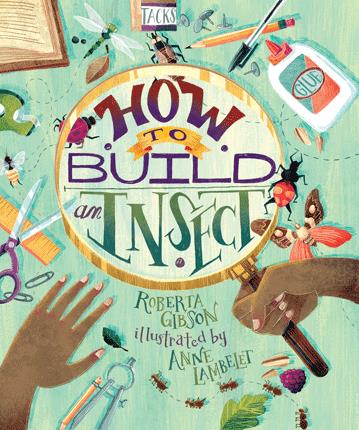| How to build an insect Author: Gibson, Roberta Lynn | ||
| Price: $24.48 | ||
Summary:
Visit a whimsical workshop and follow along as we learn How To Build an Insect! Conversational text and playful illustrations introduce readers to insect body parts.
| Illustrator: | Lambelet, Anne |
Reviews:
Kirkus Reviews (03/01/21)
School Library Journal (+) (00/03/21)
Booklist (04/15/21)
Full Text Reviews:
School Library Journal - 03/01/2021 K-Gr 4—Insect anatomy, basic body parts, and their purpose are detailed in this picture book. Insect body parts are introduced, and then compared and contrasted to human bodies. Gibson, who is an entomologist, explains new vocabulary and the science involved in how the insects' bodies work. The attractive illustrations complement the text very well and add humor; each concept is easy to understand and is smoothly applied to the next concept. On one page, the titles on a child's bookshelf include A Bug's Life Cycle and How To Bug Your Family. Gibson and Lambelet provide a fun, instructional easy reader text and a science project for children. The back matter, which consists of a glossary and a large diagram of an insect's body parts, also contains a more in-depth section on insect body parts that is accessible to fourth-grade readers. VERDICT A must-buy for elementary school and public libraries.—Nancy Call, formerly at Santa Cruz P.L., Aptos, CA - Copyright 2021 Publishers Weekly, Library Journal and/or School Library Journal used with permission.
Booklist - 04/15/2021 An opening spread reveals a work space that’s equal parts science museum, design space, and art studio. Entering with a jar of heads is no Dr. Frankenstein, but rather a brown-skinned boy who’s ready to help readers make an insect. While the short, simple text speaks directly to readers, the boy’s hands do the building. Author and entomologist Gibson begins with basic insect parts (head, thorax, and abdomen) and continues with more anatomy, from exoskeleton, legs, and antennae to wings, spiracles, and decorations (spots, spikes, horns). Guided questions focus the building process and point out differences between insects and other animals as well as within their class. For instance, crickets have ears on their knees, and caterpillars chew with mandibles while butterflies sip with a proboscis. The large-scale, textured illustrations depict a variety of insects and their anatomy in more detail. A concluding section features a double-page diagram of an insect and more information about each body part as well as directions for making an insect out of art supplies. An ideal book for turning STEM into STEAM. - Copyright 2021 Booklist.



